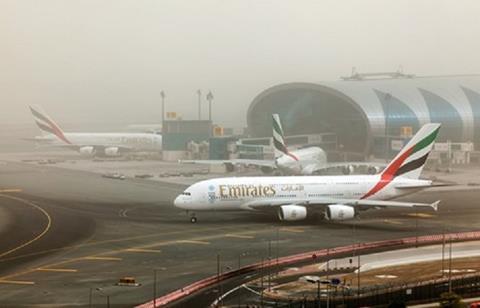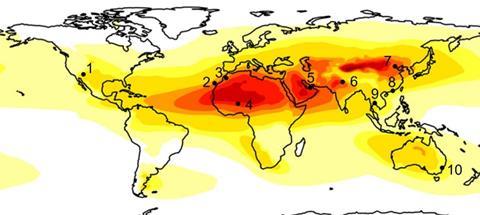Holding patterns for airports in dusty regions are particularly potentially damaging to aircraft engines, analysis of dust ingestion at 10 airports worldwide has found.
Arrival holds contributed over 50% of the total dose ingested by the engine core, according to research led by the University of Reading, which also determined that the dose during departure was 24% lower than during arrival.
This is the result of aircraft spending a prolonged period, some 10min, in the hold at altitudes which frequently coincide with – or lie close to – maximum dust concentrations.
While a previous study in 2020 had calculated engine dust dose at Doha for an Airbus A380, the new research says an assessment of dust at a wider range of airports had not been undertaken.
It examines 10 airport locations selected for their proximity to dusty regions and air traffic levels: Phoenix, Marrakech, Niamey, Dubai, Delhi, Bangkok, Hong Kong, Beijing, Sydney, and the Canary Islands.
The dust doses were found to be largest in the June-August periods, followed by March-May, for most airports, although the latter period was the most significant for Beijing and Niamey.
Calculated arrival doses were greatest for Delhi in June-August, at 6.6g, followed by Niamey in March-May at 4.7g, and Dubai in June-August with 4.3g.
“Dust doses are mostly largest in summer for descent,” the study states.

It points out that while core ingestion of 5g of mineral dust is a “negligible problem”, the cumulative dose – some 10kg for 1,000 landings and departures at a dusty hub – begins to “represent more of a problem”, accelerating deterioration of engine performance and reducing component life.
The shift towards fuel-efficient engines with hotter, higher-pressure cores and lower dust tolerance, combined with increasing operations in arid regions, means greater exposure to damage risk.
Flights operating between two dusty locations, such as Delhi and Dubai, would double the ingestion, and the study states: “Knowing how much dust is ingested during each flight phase…is as important as a knowledge of the total dust ingested for a complete flight.”
Airports with seasonal near-surface dust plumes had similar contributions from all three departure flight phases – ground, take-off and climb – while those with seasonal elevated dust plumes experienced a dominant contribution from the climb phase.
The study, newly published in the journal Natural Hazards and Earth System Sciences, used 17 years’ worth of Calipso satellite data from the European Centre for Medium-Range Weather Forecasts to calculate the dust ingestion at the 10 airports.

Lead author Claire Ryder, of the University of Reading, says research is continuing to improve the ability of climate models to predict atmospheric dust emission and transport.
“Climate models do not currently provide a consensus on whether global warming will mean a dustier world,” she says. “Dust emissions depend on a lot of factors, such as soil moisture, precipitation, surface wind patterns and vegetation cover.”
The study says diurnal cycles means dust concentration is minimal at night, and night flying can reduce dust dose.
“Many airports saw a reduction of at least 30% from night flying,” it says, adding that variations in holding altitude can also significantly reduce total dose. “However, knowledge of the dust vertical profile is crucial, since airports with elevated dust plumes can incur higher dose if holding altitude is raised into the dust plume.”


























